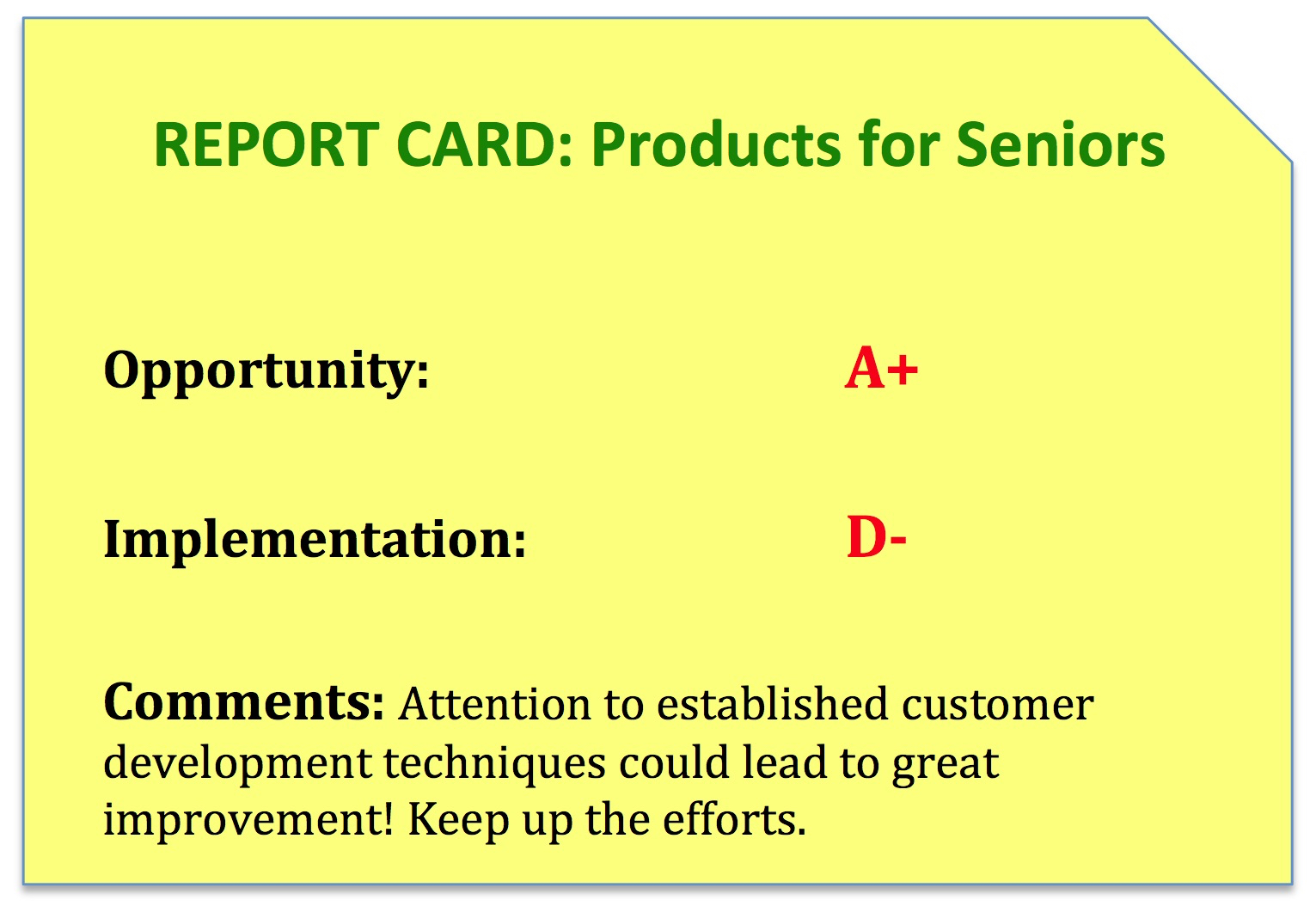By: Richard Caro | Posted: November 25, 2016 | Updated: April 5, 2023
While there is no shortage of problems for which older adults would like solutions, the vast majority of products we have looked at are either hard for elderly people to use, or do poorly the “job” our older adult demographic wants to get done.
Unfortunately, after several years of evaluating products for seniors and exploring unmet needs, and nearly 100 face-to-face group discussion and ideation sessions by the Longevity Explorer community, the above is my most striking take-away.
In Search of “Why?”
Because our community of older adult explorers is keen to find a way to help change this situation, I spent the last few months interviewing a diverse group of companies, all interested in developing products for seniors. I wanted to find out what their challenges were, and in particular I wanted to learn whether there were ways that our Longevity Explorer community could help these innovators succeed.
I learned quite a lot about how the various innovators I talked to were approaching their self-assigned missions of helping the elderly by developing new products and services. When I put this together with what I had learned from our numerous product evaluation sessions, a pattern started to emerge.
To some extent, this is a pattern of missed opportunities and avoidable errors, and if that was all I had to share it would make for a depressing article. What is more interesting to me, is that I see no profound reason why we can’t avoid the errors, and attack the missed opportunities.
This article is the first in a two-part series focused on just that. This first part is about the pattern, and about some of the reasons today’s products for seniors are so disappointing. The second part describes an approach to customer interaction that innovators can use to develop better products: products that older adults want, need and will pay for.
Products for “Patients” and the “Decrepit”: Who Wants Them?
I have lost track of how many times I have heard comments like these:
- “My father needs a cane. I bought him one, but he refuses to use it because he thinks it makes him look old”.
- “My husband has a new very expensive hearing aid, but he prefers to leave it at home when we go out in public as it makes people think there is something wrong with him”.
- “I have a medical alert pendant. It lives in my bedside table. I don’t wear it because it is very large and ugly”.
Each of these product types does indeed do something useful. And mostly they work reasonably well, although one could certainly imagine incremental improvements in each category. But older adults often have major resistance to using these products, and it very often seems to boil down to the fact that these products come with all sorts of negative connotations. And if they don’t get used, they are certainly not a success.
Maybe we “Need” these products. But we don’t “Want” them! That is a problem.
I have given quite a bit of thought to why this is, and how one could rectify it. I’ve come to believe that a root cause of this problem is that these products mostly embody a medical approach to the challenges of growing older. They are developed with the idea they will be used on “patients”. They often look rather clinical, and as though they belong in a hospital or nursing home.
But people don’t really want to be seen as patients for the rest of their life. And so they resist.
It’s as if we left out a fundamental aspect of the product requirements. Yes, these products have to improve hearing or assist with mobility. But they also need to somehow enhance one’s daily life and ability to participate as one chooses in society, without attaching to their users a new and undesirable label (infirm, over the hill, past it).
This is a non-trivial design challenge. But not insurmountable. It is not as simple as putting sequins on the cane and painting it pink, however.
As a nice, easy to articulate example, consider the medical alert pendant. It so happens we have done an exhaustive study of these, and I have personally worn many of them around town while testing them. And I can say without reservation that they are almost all ugly, uncomfortable to wear, and something one would avoid using until absolutely unavoidable. However it is not at all hard to imagine a nice elegant version of this product type, and there are even examples that exist in prototype form. Unfortunately, most of the larger vendors are not focused on this aspect of design.
It seems to me that we are missing a huge opportunity here. Many products for older adults are designed to help compensate for the challenges that come with aging. But why do they have to be ugly and stigmatizing? The answer is they do not, but product designers have not focused on this enough as yet.
Products for Everyday Life: Where are They?
I see a big gap between the products people are developing, and the unmet needs our older adults surface at our explorer meetings. Most of the products we see are for infirmities and medical challenges, and these are certainly important. But many of the unmet needs our explorers talk about relate to the difficulty of doing everyday tasks, and of “living the way they wish to”. I feel there is a huge opportunity to focus more on these aspects of aging.
The example everyone uses for this class of product is the Oxo Good Grips line of kitchen products, and I agree this is an excellent example of design that makes everyday life easier for older adults. But what is the second example? If you can think of one, please email me and let me know.
From our Longevity Explorer circles, we now have a growing list of unmet needs that fit in this “everyday life” category. It would be very exciting to start seeing solutions to some of these, but very few of the companies I talk with are even thinking about this class of “problems”.
Who is the Customer Anyway?
In my opinion, a lack of clarity about who the customer is in the design process is a major factor underpinning a seeming mismatch between what older adults want and need, and what the products we see can actually help with.
This is one of the most unsatisfactory aspects of my discussions with people developing products in this space. Below, I have collected some of the common errors I see in regard to defining the target customer for whom a product is being developed. Maybe by pointing them out here, we can think a bit more clearly about target customers and their specific needs. I feel this would help a lot.
“Senior” is not a Useful Category
I like to ask companies who they are targeting as their customer. I cringe when someone says “seniors”. AARP suggests Seniors are people over 50. That is a rather huge group. It seems to me unlikely they have enough in common to make this a useful way to think about a target demographic for a product or service without further sub-categorization.
Would you Develop the Same Product for a 2-year-old, a 12-year-old and a 22-year-old?
I had this recent conversation with a 20-something designer at one our Meetups. I asked who the target customer was for her product and she said “seniors”. I asked what ages she had in mind, and she said “over 50”. I asked if she thought the challenges of a 50-year-old and an 80-year-old might differ a bit, and it was clear this was a surprising concept she had not considered.
I pointed out that it might be similar to thinking the challenges of a 20-year-old and a 50-year-old were the same. She looked at me like I was from Mars. She clearly had never imagined she and a 50-year-old could have similar unmet needs.
“Age” is not a Useful Metric
Which brings me to another hard won “learning”, that may be obvious to you but was not obvious to me a few years ago.
People often use age as a relevant metric. “This product is for people between 75 and 85” for example. But I have come to realize that some 40-year-olds behave like they were 100 and some 100-year-olds act like they were 40. It is about functional ability and about attitude. I am not quite sure exactly how we capture that, but I don’t feel age is the most useful metric for characterizing who would benefit from any given product or service.
“Older Adult” and “Disabled” are not Synonyms
Many of the challenges of growing older, and the unmet needs older adults have, relate to things quite different to those of the physically or mentally disabled community. Yet I frequently hear discussions in which these two groups are lumped in together. This can easily lead to fuzzy thinking about the problems that need addressing.
Before anyone rushes to the comment button, this is not at all about any type of value judgment. It is about clarity. Some disabled people are old. Some older adults are disabled. The two categories overlap. But they are not the same. Both groups will fare better if we develop products with that clearly in our minds.
Is “Marketing to the Children” and Ignoring the Older Adult Really a Good Idea?
There is a fashion at present for companies to say they plan to market their new products to the families of older adults rather than to the older adults themselves. There are lots of reasons for this that sound good at first hearing. And for some products it may well make sense.
But, I am presently questioning this whole approach. I see two flaws based on my own observations of older adults and their families in our fairly sizeable sphere of interaction.
The biggest flaw I see is that the older adults I meet typically have rather strong views and opinions about what products they want in their house, and the idea of a child saying “Hey Mom, lets install this system” seems far less likely to succeed than an approach in which the older adult decides they want the product for reasons they consider important to them.
The second flaw with this approach was explained to me by an executive of a company that tried this “market to the family” strategy. Here is what he said:
“even when they talk about wanting to buy the product for their parent, the reality is that they need to choose between buying this product for the parent, or a new Fitbit or other sexy gadget for themselves, and not infrequently we lost that “share of wallet” battle.”
One’s Grandmother is not a Customer Segment
So many startup company websites explain how they developed their product for their grandmother. Are there other people like her? Did she really like the product or was she just being polite? So many questions.
What About the Middle Class?
An under appreciated aspect of aging in America is the fact that the Middle Class is the group that is going to badly need some useful new products and services that improve quality of life as they age. I see this as an important opportunity — which is not to say that other groups don’t also deserve new products. But the middle class is especially short of help.
If you think about it, the truly affluent can always get staff to help with whatever problem they have. The economically needy have a whole slate of programs from the government, which are unavailable to the middle class. And those without assets are eligible for Medicaid-funded nursing care when they need it.
The Middle Class is not able to afford butlers, and is not eligible for government-funded nursing care. It seems to me that they are really, really going to need clever products (at reasonable cost) that help them age at home as long as possible.
Customer Development to the Rescue
So far, this article is a list of things to avoid doing, and things to watch out for. Because I see a lot of companies making one or other of these errors, I am hoping this will be useful to some.
The good news, though, is that there are some well developed methodologies to find the right alignment between unmet needs, customer segments and solution features. For whatever reason, we are just not doing a good job of applying these tools to developing products for older adults.
These methodologies often get lumped together into tool boxes of techniques called “Customer Development” (for entrepreneurs) and “User-centered Design” (for designers). Many of the Customer Development techniques have been well popularized by Steve Blank (1) and by the Lean Startup movement (2).
A key element of these methodologies is interacting with potential customers early on in the product development process (Customer Interaction).
Part two of this series dives into the details of using Customer Interaction to help develop products for seniors that will meet real needs and wants.
In Part two, I also discuss how to use the same techniques to create “proof points” for managers and investors, that demonstrate that older adults will indeed want, need and pay for the products — even before a prototype exists. For startups, this is an especially important detail.
Read Part 2 in this Series:
References
(1) Steve Blank is the starting place for all things Customer Development related, especially in the context of new ventures.
(2) The Lean Startup Movement is another great source for Customer Development ideas. Start by reading Eric Ries’ book “The Lean Startup”
(3) I especially like the series of books called “The Lean Series (O’Reilly)”. Start with “Running Lean” by Ash Maurya.
*Disclosure: The research and opinions in this article are those of the author, and may or may not reflect the official views of Tech-enhanced Life.
If you use the links on this website when you buy products we write about, we may earn commissions from qualifying purchases as an Amazon Associate or other affiliate program participant. This does not affect the price you pay. We use the (modest) income to help fund our research.
In some cases, when we evaluate products and services, we ask the vendor to loan us the products we review (so we don’t need to buy them). Beyond the above, Tech-enhanced Life has no financial interest in any products or services discussed here, and this article is not sponsored by the vendor or any third party. See How we Fund our Work.


